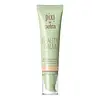What's inside
What's inside
 Key Ingredients
Key Ingredients

 Benefits
Benefits

 Concerns
Concerns

 Ingredients Side-by-side
Ingredients Side-by-side

Water
Skin ConditioningCoco-Caprylate/Caprate
EmollientGlycerin
HumectantDicaprylyl Ether
EmollientButylene Glycol
HumectantIsododecane
EmollientHydrogenated Polycyclopentadiene
Polyglyceryl-4 Isostearate
EmulsifyingCaprylic/Capric Triglyceride
MaskingPolyglyceryl-2 Dipolyhydroxystearate
Skin ConditioningHydrogenated Polyisobutene
EmollientDisteardimonium Hectorite
StabilisingMagnesium Sulfate
Pentylene Glycol
Skin ConditioningPhenoxyethanol
PreservativeMica
Cosmetic ColorantSilica
AbrasiveSorbitan Isostearate
EmulsifyingGaultheria Procumbens Leaf Extract
PerfumingHydrogenated Lecithin
EmulsifyingPropylene Carbonate
SolventSodium Hydroxide
BufferingTocopheryl Acetate
AntioxidantChlorella Sorokiniana Extract
Skin ConditioningEthylhexylglycerin
Skin ConditioningEthylene/Propylene/Styrene Copolymer
Butylene/Ethylene/Styrene Copolymer
Yeast Extract
Skin ConditioningTrisodium Ethylenediamine Disuccinate
1,2-Hexanediol
Skin ConditioningCaprylyl Glycol
EmollientSodium Carbonate
BufferingTocopherol
AntioxidantPentaerythrityl Tetra-Di-T-Butyl Hydroxyhydrocinnamate
AntioxidantCI 77891
Cosmetic ColorantCI 77491
Cosmetic ColorantCI 77492
Cosmetic ColorantCI 77499
Cosmetic ColorantWater, Coco-Caprylate/Caprate, Glycerin, Dicaprylyl Ether, Butylene Glycol, Isododecane, Hydrogenated Polycyclopentadiene, Polyglyceryl-4 Isostearate, Caprylic/Capric Triglyceride, Polyglyceryl-2 Dipolyhydroxystearate, Hydrogenated Polyisobutene, Disteardimonium Hectorite, Magnesium Sulfate, Pentylene Glycol, Phenoxyethanol, Mica, Silica, Sorbitan Isostearate, Gaultheria Procumbens Leaf Extract, Hydrogenated Lecithin, Propylene Carbonate, Sodium Hydroxide, Tocopheryl Acetate, Chlorella Sorokiniana Extract, Ethylhexylglycerin, Ethylene/Propylene/Styrene Copolymer, Butylene/Ethylene/Styrene Copolymer, Yeast Extract, Trisodium Ethylenediamine Disuccinate, 1,2-Hexanediol, Caprylyl Glycol, Sodium Carbonate, Tocopherol, Pentaerythrityl Tetra-Di-T-Butyl Hydroxyhydrocinnamate, CI 77891, CI 77491, CI 77492, CI 77499
Water
Skin ConditioningCyclopentasiloxane
EmollientEthylhexyl Methoxycinnamate
UV AbsorberTitanium Dioxide
Cosmetic ColorantZinc Oxide
Cosmetic ColorantCaprylic/Capric Triglyceride
MaskingGlycerin
HumectantCetyl PEG/PPG-10/1 Dimethicone
EmulsifyingSorbitan Sesquioleate
EmulsifyingArbutin
AntioxidantDimethicone
EmollientCI 77492
Cosmetic ColorantSodium Chloride
MaskingAdenosine
Skin ConditioningCeramide NP
Skin ConditioningRosmarinus Officinalis Extract
AntimicrobialAnthemis Nobilis Flower Extract
MaskingSodium Hyaluronate
HumectantPhenoxyethanol
PreservativeDimethicone/Vinyl Dimethicone Crosspolymer
Skin ConditioningPEG-10 Dimethicone Crosspolymer
StabilisingOzokerite
Emulsion StabilisingBeeswax
Emulsion StabilisingButylene Glycol
HumectantParfum
MaskingStearalkonium Hectorite
Gel FormingMagnesium Aluminum Silicate
AbsorbentQuartz
AbrasiveIron Oxides
Water, Cyclopentasiloxane, Ethylhexyl Methoxycinnamate, Titanium Dioxide, Zinc Oxide, Caprylic/Capric Triglyceride, Glycerin, Cetyl PEG/PPG-10/1 Dimethicone, Sorbitan Sesquioleate, Arbutin, Dimethicone, CI 77492, Sodium Chloride, Adenosine, Ceramide NP, Rosmarinus Officinalis Extract, Anthemis Nobilis Flower Extract, Sodium Hyaluronate, Phenoxyethanol, Dimethicone/Vinyl Dimethicone Crosspolymer, PEG-10 Dimethicone Crosspolymer, Ozokerite, Beeswax, Butylene Glycol, Parfum, Stearalkonium Hectorite, Magnesium Aluminum Silicate, Quartz, Iron Oxides
 Reviews
Reviews

Ingredients Explained
These ingredients are found in both products.
Ingredients higher up in an ingredient list are typically present in a larger amount.
Butylene Glycol (or BG) is used within cosmetic products for a few different reasons:
Overall, Butylene Glycol is a safe and well-rounded ingredient that works well with other ingredients.
Though this ingredient works well with most skin types, some people with sensitive skin may experience a reaction such as allergic rashes, closed comedones, or itchiness.
Learn more about Butylene GlycolThis ingredient is an emollient, solvent, and texture enhancer. It is considered a skin-softener by helping the skin prevent moisture loss.
It helps thicken a product's formula and makes it easier to spread by dissolving clumping compounds.
Caprylic Triglyceride is made by combining glycerin with coconut oil, forming a clear liquid.
While there is an assumption Caprylic Triglyceride can clog pores due to it being derived from coconut oil, there is no research supporting this.
Learn more about Caprylic/Capric TriglycerideCi 77492 is also hydrated iron III oxide. It's sole purpose is to give a yellow hue to products.
Iron III oxides are classified as inorganic chemicals for coloring.
Synthetically created Ci 77492 is considered safer than those naturally found. This is because the synthetically created version may contain less impurities. Iron oxides are generally non-toxic and non-allergenic.
Learn more about CI 77492Glycerin is already naturally found in your skin. It helps moisturize and protect your skin.
A study from 2016 found glycerin to be more effective as a humectant than AHAs and hyaluronic acid.
As a humectant, it helps the skin stay hydrated by pulling moisture to your skin. The low molecular weight of glycerin allows it to pull moisture into the deeper layers of your skin.
Hydrated skin improves your skin barrier; Your skin barrier helps protect against irritants and bacteria.
Glycerin has also been found to have antimicrobial and antiviral properties. Due to these properties, glycerin is often used in wound and burn treatments.
In cosmetics, glycerin is usually derived from plants such as soybean or palm. However, it can also be sourced from animals, such as tallow or animal fat.
This ingredient is organic, colorless, odorless, and non-toxic.
Glycerin is the name for this ingredient in American English. British English uses Glycerol/Glycerine.
Learn more about GlycerinPhenoxyethanol is a preservative that has germicide, antimicrobial, and aromatic properties. Studies show that phenoxyethanol can prevent microbial growth. By itself, it has a scent that is similar to that of a rose.
It's often used in formulations along with Caprylyl Glycol to preserve the shelf life of products.
Water. It's the most common cosmetic ingredient of all. You'll usually see it at the top of ingredient lists, meaning that it makes up the largest part of the product.
So why is it so popular? Water most often acts as a solvent - this means that it helps dissolve other ingredients into the formulation.
You'll also recognize water as that liquid we all need to stay alive. If you see this, drink a glass of water. Stay hydrated!
Learn more about Water